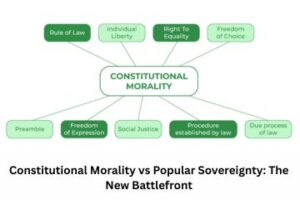Adhoc Arbitration vs Institutional Arbitration: Critical Analysis
Written by: Chhajed Ruchita Ishwar Sunita
ABSTRACT
Arbitral proceedings scholars and practitioners agree that there are two types of dispute resolution: ad hoc and institutional. This long-standing schism has infrequently been thrown into question, and it has largely served its purpose in arbitration panel practice. The current participation delves deeper into the redirect among both ad hoc and institutional arbitration by examining “borderline offensive incidents,”
or configurations that could quite effortlessly be assigned to one of these two major categories.
There are four types of borderline examples cited UNCITRAL arbitrations, particularly those prescribed by arbitral institutions, incidents in which the stakeholders have selected integrity of the system but not the granting institution (and vice versa), the stakeholders’ transformation of statutory provisions, and the recognition of a feasible “legally required” cornerstone of legal principles, and “chop and change” (or “combination”) legitimate way integrating the guidelines of one arbitration tribunal with the administering of the specific instance by a separate arbitral institution. The paper seeks to obtain a glimpse into the primary features influencing each arbitral proceedings section by analyzing the issues that were resolute in these borderline contexts being classified as institutional or ad hoc. It creates and discusses a unique interpretation of “institutional arbitration” based on all of these observations.
INTRODUCTION
Arbitration theory and practice usually conclude that there will be two types of dispute resolution: ad hoc and institutional. This axiom is so self-evident that it has seldom been hindered, and little effort was managed to determine what exactly distinguishes arbitral proceedings as institutional or ad hoc. The latter would be rather exactly a surprise, considering that the doctrine of legal capacity that prevails in dispute resolution can yield a wide range of conflict resolution creations that might not be effortlessly compensated through these two groups of controversy resolution that have been colloquially alluded to as “aspects”, “classes”, “sorts”, or “subgroups”.
The purpose of this article is to examine the customary contrast in both the two types of adjudication by examining “borderline incidents,” or groupings that cannot be smoothly assigned towards either segment. It is desired that by understanding the considerations that will ultimately determine whether the relevant conciliation proceedings are institutional or ad hoc, a perspective into the fundamental tenets of each adjudicative category will be garnered. The paper will continue as regards: it will describe recognized concepts of the two principal adjudicative groupings until elucidating whether or not the comparison is valid whatsoever. It focuses on different kinds of special case scenarios and the instruction to be drawn from them during terms of arbitral category separation. It summarises the findings and makes conclusions by explaining a broader identity of institutional arbitration, concluding fleetingly.
(A) Methodology
This research paper is based on doctrinal research and follows the basic idea so that detailed and proper knowledge can be developed about the topic. This search has both inductive and deductive methods. If seen this is theoretical research that has been demonstrated with the help of primary and secondary data that have been used to reflect the applied research methods that were adopted while writing and completing this paper. The associational approach has been taken into full consideration throughout the completion of the paper so that a proper comparison could be made between the different categories of arbitration. The descriptive sense of the paper will depict how different sources have been referred to, to reach an accurate and novice conclusion. Several previously done research papers have been referred to in addition to it online and internet websites, articles, and international laws have been taken into consideration so that an appropriate amount of knowledge could be gathered.
ACCEPTED DEFINITIONS OF ARBITRATION CATEGORIES
(A)The Traditional Ad Hoc/Institutional Arbitration Dichotomy
In arbitration proceedings, the prominence of adjudicative agreements is well documented. Its workouts can take many different aspects. These kinds of configurations, establishment independence to publish to dispute resolution, is ordered to provide relevant by parties’ collaboration determining whether to proceed with ad hoc arbitration or institutional mediation. It is not shocking, then, that the two principal mechanisms of adjudication were mostly frequently understood in the context of the participant’s choosing, and kinds of ad hoc arbitration on one contrary and institutional arbitration on the other are commonly proffered in favour of greater pros and cons.
As a result, this view considers the dividing line of adjudicative groupings as a list from which entities can be selected. There are set meals (agreed upon by the institution) and “dining à la carte” (ad hoc arbitration10). When something arrives to discuss the two options on the list, it’s worth noting that neither ad hoc nor institutional arbitration has a sincerely fixed meaning. Despite this, the interpretations being used in substantial arbitration curriculums are, for the most part, somewhat parallel. Furthermore, countless arbitration precepts are acknowledged just by characterizing institutional arbitration and then highlighting ad hoc arbitration, inferring the standard protagonist of ad hoc arbitration.
(B) Defining Institutional Arbitration
As a result, an “institutional” adjudication has been defined but one which is prescribed by a
specializing adjudicator because of its arbitration proceedings. Another conceptualization implies that institutional arbitrations are processed by infrastructural international arbitration norms, which are nearly invariably monitored by a governmental action with commitment for numerous perspectives such as forming the arbitration agreement, determining the tribunals’ reimbursement, and other sensitive issues. Another view incorporates institutional arbitration to be a dispute resolution operation carried out under the supervision of or delivered or aimed
directly by an original entity.
(C)Defining Ad Hoc Arbitration
Ad hoc arbitration, on the other hand, has predominantly been classified as the opposite extreme of institutional arbitration, as a segment spanning all non-institutional arbitration processes. Ad hoc mediation is defined by “deleterious” classifications as dispute settlement operated without such intervention of any arbitration tribunal, that is impartial of all organizations, that were already initiated without such financial advantage of a nominating and institutional jurisdiction or (typically) emphasize important dispute resolution process, or that are not administrated by an adjudicatory establishment.
They thus spectrum from no governmental intervention at all through the use of none of us governmental management nor utilization of statutory provisions to (purely and simply) no governmental management, actually nearly replicating the diverse researchers who have defined institutional arbitral proceedings. The dominant “critical” strategy of these interpretations represents the definition existence of ad hoc arbitration, given that adjudication will be ad hoc if the stakeholders are quiet about their preferred arbitral tribunal configuration. Optimistic representations of this characteristic of dispute resolution are uncommon. Ad hoc mediation is categorized as “resolution by arbitration proceedings designated for each case” in “Article I(2)(b) of the 1961 Geneva Convention11”.
(D) Challenges to the Traditional Dichotomy
In current history, the customary ad hoc/institutional dividing line has been called into question in juridical literary works. Researchers have claimed, for example, that the boundary between the two groups is sometimes not transparent, and that distinguishing them can be complicated in some case scenarios.
Similarly, this has been universally perceived as unnecessary to recognize only the disparities among both ad hoc and institutional dispute resolution to the point of absurdity without evaluating classifiers. Everyone else has emphasized that the separation really shouldn’t be overstated in any specific instance. The current involvement occupies many such hurdles and puts them to the experiment by examining a multitude of “complex cases,” that is, situations in which the supposedly fine difference between institutional and ad hoc arbitration had already largely failed to catch. In exploring such borderline groupings and their care in jurisprudence and scholarly dialogues, an initiative has been taken to establish what, if any, teachings can be drawn for the summary demarcation in both dispute resolution groupings.
BORDERLINE CASES
As previously stated, the classical ad hoc/institutional arbitration difference has been constantly questioned in recent decades, with some arguing that the lines between all these existing classifications can become obscured. The latter circumstance manifests itself in “borderline contexts,” i.e., incidents that can still be registered in either of the two types without difficulty. Four such borderline observatories will be researched to see what teachings can be drawn from their intervention in jurisprudence and scholarly debates about the demarcation between institutional and ad hoc arbitration in a broad sense.
All four constellations discussed below have one similar theme: They are the direct consequence of parliamentary sovereignty, which is a founding concept of all arbitral awards and, in theory, also needs to apply in dispute settlement. The classically straightforward line among both ad hoc and governmental dispute resolution fades where the stakeholders have specially executed their independence. The cases are- “UNCITRAL Arbitrations Involving Arbitral Institutions, Parties’ Choice of Institutional Rules, but Not of the Issuing Institution (and Vice Versa), Modification of Institutional Rules by the Parties”.
If a dispute resolution organization titled “in an arbitral proceeding declines to distribute the mediation because the stakeholders deviated from clauses in the institutional arbitration clause that the entity deems non-detonatable, the private arbitration could perhaps push ahead as a dispute settlement. In such a case, if the party leaders and the appellate award proceed, the adjudication will proceed as an institutional arbitration. This implies that the ability of an adjudicator to voluntarily safeguard the intrinsic qualities of its infrastructural agreement to arbitrate is what distinguishes institutional litigation from other types of adjudication.
The conversation of exceptional cases has acknowledged that the classically pervading strategy of identifying only two types of mediation hoc arbitration on the one contrary, and institutional arbitration on the other—remains persuasive, though in the face of borderline groupings that might have been complicated. In plenty of other utterances, it is neither requisite nor informative to implement additional (e.g., “blends”) groupings of dispute resolution for the reasons, of course, recognized sooner. Ad hoc arbitration is the standard component among some of the two adjudication types. It includes all mediation proceedings that do not have satisfactory active participation of arbitration agreements or their administrative regulations, as well as international arbitration that do have some governmental complicity but do not have the essential “intermediary component.”
NOVEL DEFINITION
In light of the knowledge gained, a modern term of “institutional arbitration” could be as
regards: “An adjudication is institutional if the groups have devolved to this arbitration court the potential to implement verdicts upon such court judgments by consenting on an organization’s tribunals.” Any litigation that does not meet or no longer meets these
specifications is an ad hoc arbitration.
CONCLUSION
The demarcation between institutional arbitration and ad hoc arbitration is a core belief of dispute settlement policy and research. The accurate and consistent key terms of these two principal adjudicative classes are poorly studied because they are used principally for illustrative applications.By examining four broad categories of complex cases, the actual chapter sought to obtain some understanding of the determinants that determine whether an arbitral tribunal is “organizational” or “ad hoc.” Arbitrations undertook by a post sequence of the arbitration clause, though without or with minimal support of an adjudicator exerting as contacting executive power or delivering solutions; unconnected party alternatives of only formal procedures or only an arbitration proceedings organization; establishment reconfiguration of governmental uncitral rules (and the limitation of “legally required” protections in those norms); and “chop and change” arbitral awards integrating one organization’s dispute resolution process with the management of the prosecution by a different arbitral institution.
Keywords: Ad-hoc arbitration, Institutional arbitration, international arbitration, arbitral
institutions, 1958 New York Convention, 1961 Geneva Arbitration, UNCITRAL Model
Law, UNCITRAL Arbitration Rules, mandatory institutional rules, hybrid arbitrations, mix and match arbitrations, administration of arbitrations.




